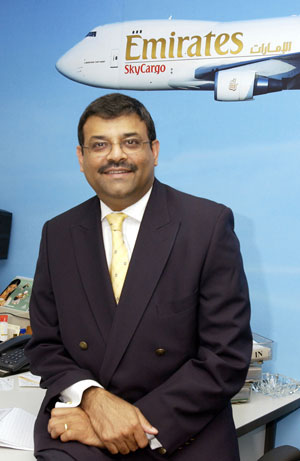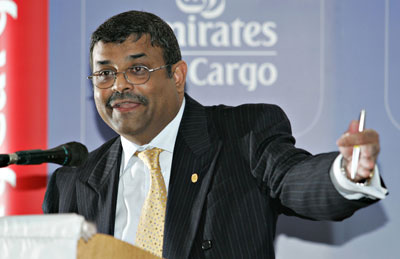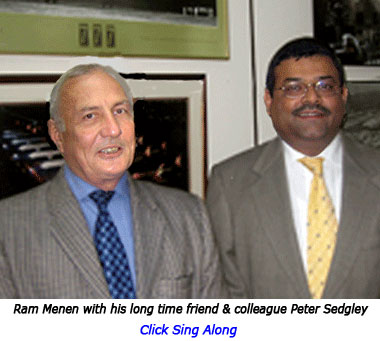Ram Menen Looking At Tomorrow
 It
should have come as no surprise when last week it was announced that Emirates
SkyCargo is now the number one air cargo resource on the planet to utilize
paperless movement of its air freight product, or ‘efreight.’ It
should have come as no surprise when last week it was announced that Emirates
SkyCargo is now the number one air cargo resource on the planet to utilize
paperless movement of its air freight product, or ‘efreight.’
Right now, Ram Menen, the SkyCargo Divisional
Vice President, has quietly become among the longest serving and most
prolific executives in the history of the form.
Emirates SkyCargo 2010 continues as a dynamic
innovator, changing the playing field for air cargo the world over.
What’s more, Emirates is not finished,
but maybe just ending its beginnings.
While it has been fashionable to admire,
for example, Singapore Airlines, Emirates in every measure will eclipse
even that island nation’s great international carrier.
One of my earlier memories of Ram was walking
into a room where I found him huddled inside the Dubai World Trade Center,
mulling over some papers with his friend and long time colleague at Emirates
Sky Cargo, Prakash Nair.
Dubai was hosting The International Air
Cargo Association bi-annual event in 1996; the New York Yankees were winning
their first World Series in 18 years; TIACA, on the brink of collapse,
was saved by the money it made at the UAE event.
We had spoken previously in Seattle at another
less illustrious TIACA event two years earlier (if memory serves, the
SeaTac guy who hosted the event lost his job shortly after TIACA left
town).
TIACA Seattle was a “keep it going”
affair after Bob Arendal brought the organization back from extinction
by hosting in Luxembourg in 1992.
It was another time made no less memorable
by the attendance and access to HH Prince Maktoum of Dubai, who was at
the event and (amazing as it may seem today) often evident inside the
SkyCargo display stand, where he smiled amiably and chatted with just
about everyone.
It’s doubtful that even the most visionary
precognitive could have foreseen the rise of Emirates Airline 16 years
ago, as both a world aviation power and industry icon.
It is even more unlikely to have supposed
that Ram Menen would have continued to steer the course and remain at
the helm of a major world cargo carrier as long as he has, longer than
any airline top executive in the history of the business.
But that is exactly what has happened.
The kid from the tent alongside the runway
at DXB, humping and running cargo in and out of a couple of leased-in
aircraft from Pakistan in preparation of a new airline called Emirates,
is now the senior air cargo executive, and for all his service and charity
back to the industry and to others along the way, Ram is at the very top
when measuring the greatest airline air cargo executives of all time.
Ram Menen dresses formal—always in
a dark suit with white shirt and tie.
But don’t let the business uniform
fool you.
Ram is approachable by anybody; a down-on-the-ground
kind of guy who knows a thousand air cargo areas, the best place to enjoy
some delicious dosa, and how to stay in touch with the most critical area
in the movement of freight.
We spoke to Ram after the stunning news
that new A380 aircraft orders are in, meaning that at some point, the
carrier will operate 90 (or more) of the super jumbos and annual financials
came in quite positive as well. It may be hard to believe, but after a
generation Ram seemingly can’t wait for tomorrow and thinks things
look better everyday.
Works for us.
ACN/FT: Now
that the annual financials have been released for Emirates Group last
year, can you describe how important is air cargo to the Group and how
do you view performance during the past year?
RM: Cargo
revenue, including mail and courier, contributed 17.2 percent of the airline’s
total transport revenue.
Our flexibility and ability to adapt quickly
to changing market conditions led to Emirates SkyCargo rightsizing its
fleet during the financial year.
Emirates SkyCargo decreased its fleet from
eight aircraft to seven – including five Boeing 747Fs and two Boeing
777Fs – helping to ward off the adverse effects of the economic
downturn.
ACN/FT: What
do you expect for 2010-11 and what are you looking for in terms of driving
growth that will tell you business is developing as planned?
RM: 2010/11
is already performing better than last year and we are expecting volumes
to grow by about 20 percent this year.
ACN/FT: What
do you consider the absolute top priority right now?
RM: Getting
the right product mix to increase our yields and to have the right capacity
at the right place all the time.
ACN/FT: Are
there any programs or product development or destinations you would like
to engage that perhaps were on the back burner during the recent challenging
financial climate?
RM: The
airline ran a very strict cost containment program during 2009 and we
only launched two new destinations – Durban and Luanda (and Kabul
for freighters), the fewest since 1998. Already this year Emirates has
launched services to Tokyo, Amsterdam (as a passenger destination, we
have been flying freighters there for 15 years), with several others due
to start in coming months – Prague began July 1st, Madrid (August
1st) and Dakar (September 1st).
We also restarted our freighter service
to JFK and are also operating 747Fs into Incheon.
Last year, in the midst of the crisis, we
took delivery of two brand new 777Fs.
So while everyone else was shedding capacity
we were receiving these new-generation freighter, which obviously gave
us a few sleepless nights beforehand! But, as I’ve said to you since,
the 777F is a fantastic, very economical aircraft that has served us very
well.
And now we can hardly wait to receive more!
ACN/FT: What
areas of the world will you concentrate upon in terms of market development?
RM: We
are opening several new passenger destinations this year, which obviously
afford new cargo opportunities – Dakar is a new one, Prague and
Madrid to a lesser extent because we have been operating offline services
there for a number of years.
Africa is somewhere that Emirates as a group
sees huge potential.
Geographically, we are well placed to serve
the continent and in terms of services, we operate scheduled freighter
and passenger flights to 18 destinations on the continent (Dakar will
be 19).
ACN/FT: Can
you describe 2009-10 service additions in terms of performance? For example,
are you satisfied that India is thoroughly covered as well as China and
the rest of Asia?
RM: We
operate to 10 cities in India and throughout the last year when volumes
out of the Far East were declining significantly – and rates with
it – India weathered the storm remarkably well.
ACN/FT: What
about equipment? What aircraft perform best for air cargo at Emirates
and how many are in fleet and are to be added?
RM: The
777F is an amazing aircraft – fuel efficient, economical, environmentally
friendly in as much that it has lower emissions than some of the older
freighters operated by some carriers.
We are flying ours up to 16 hours a day.
So far we have two in our fleet with a further two on firm order and four
options.
We also have five 747-8Fs on firm order,
with a further option for five more.
ACN/FT: As
the biggest customer for A380, who once even had orders for a freighter
variant, can you explain how such a giant aircraft—in fact, amongst
the two or three largest on the plant—has such poor characteristics
for air cargo?
RM: How
much lift does SkyCargo get from an A380?
We were pleasantly surprised when we started
flying the A380 that it took more cargo than initially expected.
With a full load to Toronto, for example,
it can carry 10 tons; to London, 14 tons.
ACN/FT: How
will that lift figure into your air cargo service at the point that EK
is operating nearly four dozen?
RM: Make
that 90!
Fortunately we have nine new-generation
freighters on firm order with nine options, so we will most probably exercise
all of the options.
ACN/FT: Will
there ever be an A380F in Emirates SkyCargo livery?
RM: I
don’t think so… I believe the A380F program itself is on the
back burner for the time being …
  The
best way to achieve some of our main goals over the next few years
such as 100 percent paperless transactions is to communicate with
all the stakeholders The
best way to achieve some of our main goals over the next few years
such as 100 percent paperless transactions is to communicate with
all the stakeholders  through
one voice. through
one voice.
|
ACN/FT: Taking
an industry view, what do you see as the universal challenge that affects
all of air cargo and must be overcome in 2010?
RM: What
must be done?
The universal challenge that we have is
that of the health of world economy and how unpredictable it has become.
So far 2010 is looking good and I hope it
stays that way for a long time. However, the challenges that some of the
Euro zone countries are facing need to be seen.
Weaker Euro would/should help the exports
from the Euro zone—provided the industrial actions don’t weigh
down these countries.
Changing security requirements are also
creating some havoc.
The frequency of natural disasters and its
effect on the various economies is also a concern.
Having said that, we are used to dealing
with challenges of some sort every year; we overcome that by being agile
and flexible in our approach so that we can react to the situation quite
quickly.
ACN/FT: You
have been an ardent supporter of TIACA ever since Dubai put that organization
on solid financial ground by supporting and hosting their forum and trade
show in 1996.
With all the changes in air cargo why do
you still support TIACA and what do you look forward to, as that group
offers its bi-annual trade show in AMS this November?
RM: You’re
right; I am a firm believer in the benefits of meeting your customers
and partners face to face and TIACA shows provide a great platform for
this. As you say, there are many changes in the air cargo industry, and
many more to come if we are achieve some of our main goals over the next
few years such as 100 percent paperless transactions. The best way to
achieve these is communicating with all the stakeholders through one voice.
TIACA’s membership is diversified
and we have stakeholders from all walks of our industry present within
the association.
It is a great platform to create one voice.
ACN/FT: When
you are not at work, what are your hobbies or other interests?
RM: When
am I not at work?? (laughs)
All my interests and hobbies have been merged
into one for better efficiency …
ACN/FT: What
is the name of your favorite restaurant and where is it located?
RM: Curry
in a Hurry… I am still trying to find it!
 ACN/FT:
We understand that Peter Sedgley, SkyCargo SVP Commercial
Operations is retiring. ACN/FT:
We understand that Peter Sedgley, SkyCargo SVP Commercial
Operations is retiring.
Can you describe your feelings for him and
what he has done to impress and perhaps inspire you over the years?
RM: Obviously,
after having worked together for almost a couple of decades and having
had the wonderful opportunity to create what we have been able to, it
is very difficult to see him hang his hat.
Most of all I will miss his views about
the birds, the bees and the world, which may not always be politically
correct.
I will also miss having the quite enthusiastic
discussions that always ensured everybody is in touch with ground reality.
He is a one of a kind, die-hard cargo professional
and is one of the best men to have on your wings, especially when you
are flying by the seat of your pants..
I wish him all the best and good luck in
getting his personal life back!
Although he is retiring, he will always
remain a friend and still be a part of our SkyCargo family.
ACN/FT: Finally,
if there were a couple of things about air cargo that you were given the
power to change at once, what would they be?
RM: Collaborative
attitude, transparency . . . visibility throughout the
entire supply chain.
Everybody to 100 percent e-freight.
|



